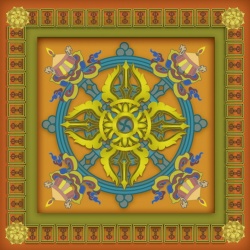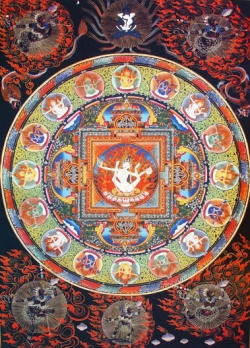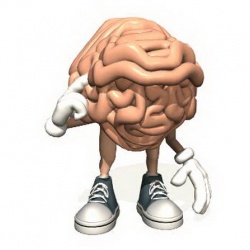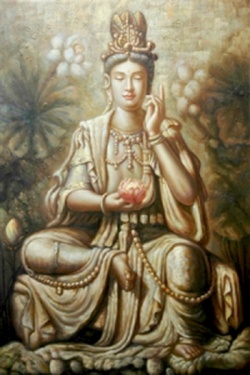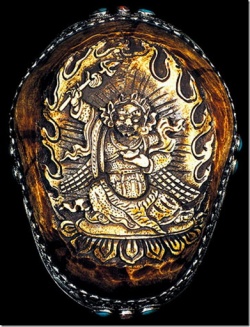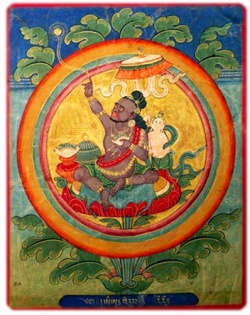Hanmi Buddhism: Chinese Esoteric School
Welcome to Hanmi Esoteric School, reviving ancient culture in the modern world to benefit all people, and providing practical solution for real world suffering. The Esoteric School of Buddhism traces its lineage to Sakyamuni Buddha. It continues down to Nagarjuna, Nagarjuna to Nagabodhi, Nagabodhi to Vajrabodhi, Vajrabodhi to Amoghavajra, and Amoghavajra to Huisu. The lineage continues down to Huitong, Huitong to Huiling, Huiling to Dechan Jueren.
The Kaiyuan's Three Great Enlightened Masters, Subhakarasimha, Vajrabodhi,and Amoghavajra, established Esoteric Buddhism in China from AD 716 to 720 during the reign of emperor Tang Xuanzong (or Hsuan-Tsung).
They came to Daxing Shansi, Great Propagating Goodness Temple, which was the predecessor of Temple of the Great Enlightener MahaVairocana. Daxing Shansi was established in the ancient capital Chang'an, today's Xi'an, and became one of the four great centers of scripture translation supported by the imperial court. They had translated many Buddhist scriptures, sutra and tantra, from Sanskrit to Chinese. They had also assimilated the prevailing teachings of China, Taoism and Confucianism, with Buddhism, and had further evolved the practice of The Esoteric School. They brought to the Chinese a mysterious, dynamic, and magical teaching, which included mantra formulae and rituals to protect a person or an empire, to affect a person’s fate after death, and, particularly popular, to bring rain in times of drought. It is not surprising, then, that all three masters were well received by the emperor Tang Xuanzong, and their teachings were quickly taken up at the Tang court and among the elite. Mantrayana altars were installed in temples in the capital, and by the time of emperor Tang Taizong (Tai-Tsung, r. 762-779) its influence among the upper classes outstripped that of Taoism. Relations between Amoghavajra and Taizong were especially good. In life the emperor favored Amoghavajra with titles and gifts, and when the master died in 774, he honored his memory with a stupa, or funeral monument.
Subhakarasimha (637-735), an eminent Indian Tantric master, arrived in the capital Chang’an in 716 and translated the Vairocanabhi-Sambodhi-Tantra, better known as the MahaVairocana-Sutra, or Great Sun Buddha Scripture. Four years later another master, Vajrabodhi (670-741), and his pupil Amoghavajra (705-775), arrived, and proceeded to translate other scriptures, thus establishing a second, though not rival, Mantrayana (Chen-Yen, or Zhen-Yan) lineage.
Vajrabodhi (671-732), an Indian Buddhist master, and a graduate of the Nālandā Monastery, received complete empowerment and transmission from Nagabodhi, who in turn received from Nagarjuna. He was born of a South Indian Brahmin family, and his father was a priest for the royal house. Vajrabodhi probably converted to Buddhism at the age of sixteen, although some accounts place him at Nālandā at the age of ten.
He studied all varieties of Buddhism and was said to have studied for a time under the famous Buddhist logician Dharmakīrti. Under Santijnana, Vajrabodhi studied Vajrayāna teachings and was duly initiated into yoga. Leaving India, Vajrabodhi traveled to Sri Lanka and Srivijaya (present-day Sumatra), where he apparently was taught a Vajrayāna tradition distinct from that taught at Nālandā. From Srivijaya he sailed to China via the escort of thirty-five Persian merchant-vessels and by AD 720 was ensconced in the Jian’fu Temple at the Chinese capital, Chang'an (present-day Xi’an). Accompanying him was his soon-to-be-famous disciple, Amoghavajra.
When Vajrabodhi arrived in Chang'an, Subhakarasimha had already been there for four years. Subhakarasimha was eighty some years old. Vajrabodhi was about thirty something, and Amoghavajra a teenager. Subhakarasimha and Vajrabodhi met and debated. Afterward, they bowed to each other as each other's teacher.
Like Subhakarasimha, who preceded him by four years, Vajrabodhi spent most of his time in ritual activity, in translating texts from Sanskrit to Chinese, and in the production of Esoteric art. Particularly important was his partial translation of the Sarva-Tathāgata-Tattva-Samgraha between the years 723 and 724. This Yoga Tantra, along with the Mahāvairocana Sutra translated by Subhakarasimha the same year, provides the foundation of the Chen-Yen school in China and the Shingon and Esoteric branch of the Tendai schools in Japan.
Like Subhakarasinha, Vajrabodhi had ties to high court circles and enjoyed the patronage of imperial princesses. He also taught Korean monk Hyecho, who went on to travel India. Vajrabodhi died in 732 and was buried south of the Longmen Grottoes. He was posthumously awarded the title Guoshi, 'National Master'.
Amoghavajra (705-774), a Singhalese, was the most famous Yogacharya of his time. He was a prolific translator who became one of the most politically powerful Buddhist monks in Chinese history, acknowledged as one of the eight patriarchs of the doctrine in Shingon lineage.
Born in Samarkand of an Indian father and Sogdian mother, he went to China at age 10 after his father's death. In 719, he was ordained into the Sangha by Vajrabodhi and became his disciple. He also became Subhakarasimha’s disciple a few years later. Both Subhakarasimha, the holder of the Garbhadhatu Womb Realm teachings, and Vajrabodhi, the holder of the Vajradhatu Thunderbolt Realm teachings transmitted the Dharma Lineage to Amoghavajra, who began the Not-Two Dharma Teachings of Garbhadhatu and Vajradhatu. The Tang emperor granted Dharma instruments to Amoghavajra to setup the first Abhiseka-Bodhi-Mandala at Daxing Shansi, thus began the Chinese Esoteric School.
After Vajrabodhi's death in 732, and at his wish, Amoghavajra went on a pilgrimage in search of esoteric or tantric writings, visiting Ceylon, Southeast Asia and India. During this voyage, he apparently met Nagabodhi, master of Vajrabodhi, and studied the Tattvasamgraha system at length. He returned to China in 746 with some five hundred volumes, and baptized the Emperor Tang Xuanzong. He was especially noted for rainmaking and stilling storms. In 749 he received permission to return home, but was stopped by imperial orders when in the south of China.
In 750, he left the court to join the military governorship of Geshu Han, for whom he conducted large-scale tantric initiations at field headquarters. In 754, he translated the first portion of the Tattvasamgraha, the central text of Esoteric Buddhism, which became one of his most significant accomplishments. He regarded its teachings as the most effective method for attaining enlightenment yet devised, and incorporated its basic schema in a number of writings.
In 756, under emperor Suzong, Amoghavajra was recalled to the capital. He was captured in general An Lushan's rebellion but in 757 was freed by loyalist forces, whereupon he performed rites to purify the capital and consolidate the security of the Tang state. Two years later, he initiated the emperor Suzong as a cakravartin.
In 765, Amoghavajra used his new rendition of the Scripture for Humane Kings in an elaborate ritual to counter the advance of a 200,000-strong army of Tibetans and Uyghurs, which was poised to invade Chang’an. Its leader, Pugu Huaien, dropped dead in camp and his forces dispersed.
The opulent [[Jin’ge [emple]] on Mt. Wutai was completed in 767, a pet project of Amoghavajra's, and one of his many efforts to promote the Bodhisattva Mañjuśrī as the protector of China. Amoghavajra continued to perform rites to avert disaster at the request of the emperor Tang Taizong. His time until 771 was spent translating and editing tantric books in 120 volumes, and the Yogachara rose to its peak of prosperity.
He died greatly honored at 70 years of age, in 774, the twelfth year of Taizong, the third emperor under whom he had served. On his death, three days of mourning were officially declared, and he posthumously received various exalted titles. He was given the title of the Thesaurus of Wisdom, Amogha Tripitaka and the posthumous rank and title of a Minister of State.
The Chinese monks Huilang, Huiguo and Huilin were among his most prominent successors. Seventy-seven texts were translated by Amoghavajra according to his own account, though many more, including original compositions, are ascribed to him in the Chinese canons. Huiguo was the most well-known disciple of Amoghavajra. Both Amoghavajra and Huiguo were emperors' guru, in other words, they were National Masters. Huiguo's main residence was the Qinglong Temple.
Historically, The Esoteric School was thought to be lost when Emperor Tang Wuzong, fearful of the popularity and the magical abilities of the practice, banned the teaching.
Huiguo had a Japanese student, Kukai, who returned to Japan and established the Japanese Shingon Buddhism. Kukai, like his teacher, became a National Master and was given the title of Kobo Daishi, or the Great Teacher Expounding the Dharma. Koyasan Shingon, south of Kyoto, Japan, is the center of Japanese Esoteric Buddhism.
Unknown in history, Amoghavajra's last disciple, Huisu, who received all the religious instruments and dharma transmission, became the Dharma Lineage Holder. Since then, The Esoteric School has been underground for over twelve centuries. The Dharma Lineage has been passed on through one master per generation.
Dechan Jueren is MahaVairocana Dharma King, the 49th Lineage Holder of the Esoteric School, the 47th Lineage Holder of the Linji Chan School, the honorable abbot of the 1000-year old Longquan Monastery in Inner Mongolia's Chifeng, the vice-abbot of Wendu Monastery in Qinghai Province, a Traditional Chinese Medicine doctor, and acknowledged as a Living Buddha in China.
Dechan Jueren, Master Yu Tianjian, from Chaoyang, Liaoning Province, at the age of 39, attained self-realization under the guidance of the 48th Mahacharya of The Esoteric School, Grandmaster Huiling of Putian, Fujian Province.
Dechan Jueren sees the past, the present and the future, and understands his mission as the Dharma Lineage Holder. He resigned his position as a plant manager in China, and donated all his savings of over one million RMB to the cause of reviving Buddha-Dharma. He said, "I want to let people know the truth of the Buddha-Dharma again." He experienced all kinds of hardship as he journeyed over great rivers and mountains in order to transmit Dharma and to heal people. He has left indelible impressions everywhere. In 1989, a discovery was made in the heaven palace of the North Pagoda at Chaoyang City, Liaoning Province. They found sharira, or the bone relic of the Buddha himself, sutra and tantra engraved in silver plates in Chinese, two Chinese Stupas of the Vajradhatu and the Garbhadhatu, and the Stupa of the Five Wisdom Buddhas.
Later, a mandala of The Esoteric School was also discovered in the crypt, the earth palace, of Famensi, or Dharma Doorway Temple at Fufeng County, Shaanxi Province. These discoveries predict the revival of The Esoteric School. Grandmaster Huiling found Dechan Jueren on the 99th days after the discovery. Dechan Jueren received complete empowerment and transmission, and became MahaVairocana Dharma King, the 49th Mahacharya of The Esoteric School.
I am MahaVairocana Dharma King. I received the lineage from Mahacharya Huiling of Esoteric Buddhism. The initiation took place at Zhaojue Monastery in Sichuan, China, with the renowned Master Qingding as the witness. I received all and every dharma instrument, sutra, tantra, robe, and crown of Subhakarasimha, Vajrabodhi and Amoghavajra. I am the sole lineage holder.
I began transmitting dharma to the public since 1990 in order to reveal the exquisite spirit of esoteric dharma that was hidden for more than a thousand year. He who comes in contact with it shall grasp the method of knowing oneself and will be able to apply the means of changing oneself.
By letting people to discover the existence of one's bad root-nature and by applying the how-and-what-to-do so as not to allow the bad root-nature to rise again, then the beast nature can be withered. Only so can we let people to liberate themselves from their self-limitation and the restriction of the environment's condition.
Only when people have grasped these methods, then they would no longer limit themselves. This is the method to "expose the truth of appearance". Thus, people shall really know the method to break through the form of the ego, of the human, of all living beings and of the long-life ones.
The method can make people really see the ignorance, attachment, and limitation of a human life that brought to oneself every suffering. Only when he who has truly grasped and applied such dharma, he will be able to liberate himself from suffering.
Dechan Jueren visited Los Angeles for the first time to attend the International Association of Integrated Medicine at the University of Southern California on July 26, 1998. His thesis on calcium enrichment through meditation practice won the golden award.
On April 1, 1999, Dari Rulai Temple was founded as the seat of MahaVairocana Dharma King.
Dechan Jueren attended the United Nations Millennium World Peace Summit of Religious and Spiritual Leaders. He was appointed as a Special Advisor of the World Council of Religious Leaders in 2007.
Dechan Jueren visited U.K. and Ireland for the first time in 2007.
On August 15, 2008, the 105-year old Grandmaster Fozhi, the abbot of Yingtian Monastery in Chengdu, Sichuan, passed on the Dharma Lineage Holder-ship of the Linji School of Chan/Zen Buddhism to Dechan Jueren. MasterDechan Jueren became the 47th Dharma Lineage Holder of the Linji Chan/Zen Buddhism, and the 16th Lineage Holder of the renowned Zhaojue Monastery.
